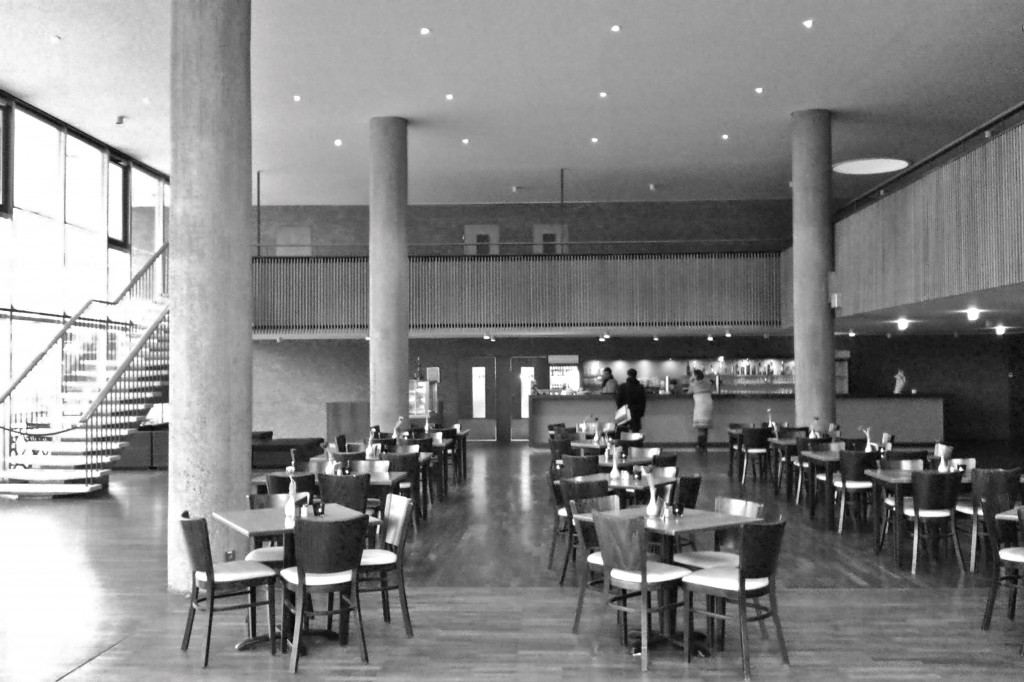Hidden Mid-Century Modernism at the Haus der Kulturen
I am about to visit one of Berlin’s most beautiful, undiscovered and under-appreciated interiors.
Take the 100 bus through the Tiergarten and get off at the Haus der Kulturen der Welt (House of World Cultures). The exhibition and festival space was built as a congress hall in 1957 with American money and an American design––by architect Hugh Stubbins Jr., who was Walter Gropius’ assistant. The hall was an ideological gesture, to show the strength of Western modernist design in a location very close to where the Wall once stood. Seen as an expression of ‘free thought’ and ‘free expression’ (with an obvious implicit accusation eastward), its most striking feature is a remarkable curved and suspended roof. Its bulging shape led Berliners affectionately to call it the ‘pregnant oyster’.
In the year leading up to the Reagan election (1980), the roof collapsed killing one person and injuring five others. The disaster was spectacular, with the roof’s enormous panels hanging indecorously from above. It was as if something exploded from within.
There are plenty of Berlin myths why.
Did it collapse because of the continual sonic boom of Russian fighter jets aggressing Western institutions? I’m drawn to this explanation: that the cold war, and the arms race, was paralleled by an architecture race, and modernist buildings became ideological and military targets. The conspiracist explanation is that the original engineers did not believe that Stubbin’s suspension roof would hold. American idealism came up against German logistics. Did local builders secretly add unnecessary and eventually disastrous ‘improvements’ that led to the 1980s collapse? I believe the engineers’ verdict: that a combination of bad concrete, corrosion and too much surface tension led to the disaster. For some it’s a continually failed building, for others it is just a long labour of love. The building was reopened first in 1987 and then again in 2007.
I love how it looks space-aged, but also a thing of the past, like its Niemeyer counterparts in Brazil. It is a perfect place to house the annual Transmediale festival, which focuses on the intersections between art, culture and technology. The festival is also a good excuse to make my way to one of Berlin’s best spaces, hidden around the back: the café.
The café overlooks the river. The tables and chairs are utilitarian, they would do better to install some vintage fifties furniture, some mid-century Modern like Jacobsen whose Grand Prix chair was issued the same year the Congress Hall was built. The food smells a little pickled, one is slightly nervous about what one will be served. So just order a tea and take a seat and look up.
The effect of simplicity, minimalism and openness, is jaw-dropping. The room has enormous windows, blurring the sense of interior and exterior. There are clean lines, an elegant stairwell leads to a gallery. It is a place to sit and look out the windows, to feel buoyed by the airiness, by the excess of space. The pillars are uplifting. It could be a hangover cure, or a remedy for depression, a way to pry open the narrowing of perspective.
And you will likely have it all to yourself.
Perhaps Berliners are deterred from sitting inside, knowing what they do about the roof.




What a fantastic building. It reminds me of the Spodek in Katowice, Poland, but much, much better.
Tom